WE'RE ONLY IN IT FOR THE MONEY: THE SIXTIES
In 1967 the Los Angelos freak scene was completely overrun by the world wide spreading Flower Power movement, that had
its origins in San Francisco. Zappa wasn't fond of their ideas, certainly not their positive attitude towards drugs. His
music already needs concentration playing it sober, so the idea of musicians on drugs while he was paying for their time
was unacceptable for him.
On his contrary album "We're only in it for the money", he reproduces their ideals while at the same time adding
demeaning remarks to it ("forgive me because I'm stoned"; "flower power sucks"). Because the Flower Power movement
lost its innocence and impact with the Rolling Stones concert at Altamont in 1970, "We're only in it for the money"
has with hindsight become a reflection upon the sixties. Zappa still found himself kicking at remnants of the
movement in his eighties songs "The blue light" and "We're turning again".
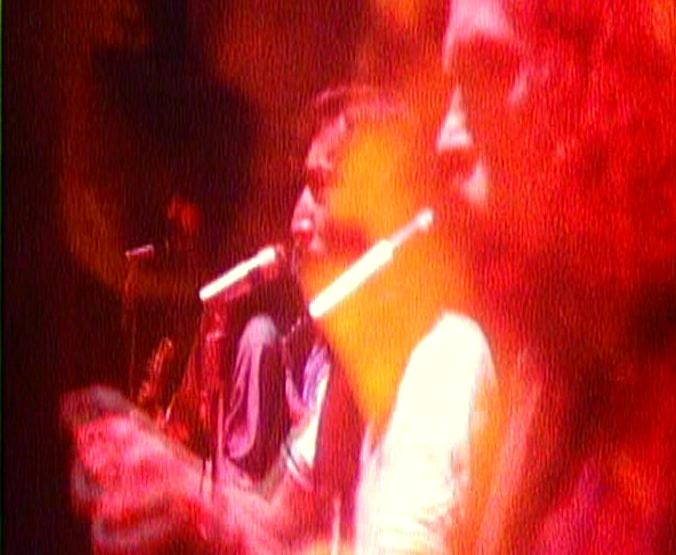 The music on the album is - regarding meters, rhythms and chord progressions - less complicated and it is an example of the more commercial
side of Zappa. Still there can be some complex parts in it. The construction of the songs on the album can also be sophisticated. "Flower punk" is as a progression
for instance relatively easy. "What's the ugliest part of your body?" below deals with rhythmic complexities.
In "The Real Frank Zappa Book" of 1989 Zappa uses three pages arguing against the "hateful practices" of
traditional harmony, especially the chord progressions that are played over and over again in pop music and
the chords of resolution you had to write down to pass a harmony course (The Real Frank Zappa Book, chapter 8,
section "hateful practices"; Zappa!, page 32).
The music on the album is - regarding meters, rhythms and chord progressions - less complicated and it is an example of the more commercial
side of Zappa. Still there can be some complex parts in it. The construction of the songs on the album can also be sophisticated. "Flower punk" is as a progression
for instance relatively easy. "What's the ugliest part of your body?" below deals with rhythmic complexities.
In "The Real Frank Zappa Book" of 1989 Zappa uses three pages arguing against the "hateful practices" of
traditional harmony, especially the chord progressions that are played over and over again in pop music and
the chords of resolution you had to write down to pass a harmony course (The Real Frank Zappa Book, chapter 8,
section "hateful practices"; Zappa!, page 32).
Above: the Mothers playing at the Garrick Theater, New York 1967. Source: Overnite sensation/Apostrophe (') DVD.
Below at track 7 a ticket stub collage I found on the net. You can see that the shows at that time carried the title "Pigs and repugnant".
Zappa's attitude towards traditional harmony is ambiguous however, because he applied common chord progressions
with just as much ease as he liked to deviate from them. See the Joe's Garage section for Joe's love declaration to I-IV-V.
He even had a weakness for deliberate simplicity, represented in the teenage love songs
from "Cruising with Ruben and the Jets" (1968). Sections from "Absolutely free", "Harry you're a beast" and "Mother people" are included below as examples of uncomplicated
chord progressions (all 5th chords unless indicated). The Cruising with Ruben and the Jets section contains of few more similar examples.
It's a commonplace in rock 'n roll history that "Sergeant Pepper's lonely hearts club band" by the Beatles is the first
concept album, usually without explaining what then this concept is. I guess it's the packaging, the instrumentation and
maybe the quality of each individual song. Some Zappa fans have argumented that the Mother's first two albums could then
be considered concept albums as well. Indeed all Zappa's albums each have some form of a conceptual idea behind them.
It can be regarding style, it can be in the lyrics and it's about always present in the sound of an album. For "We're only in it for the money" and
the next "Cruising with Ruben and the Jets" album the concept is outspoken and obvious, regarding both the music and the lyrics. "We're only in it for the money" is about
the hippie era with relatively main stream music combined with various experimental tracks and sections.
1. Are you hung up?
The album opens with "Are you hung up?", one of a number of collages of spoken texts and sound effects, frequently mutated.
This title can be subdivided into a couple of blocks:
- 0:00 The track starts with a pulsing low A by an electronic bass and a human voice. On top of it extremely high squeacking
and hissing sounds can be heard at different volume levels. In the middle range some other electronic notes are audible in the background, a bit like howling wind.
It's not composed music in traditional terms: it knows no meter and as sheet music it can only be approached as in the example below.
Are you hung up?, 0:00-0:07 (sketch).
- 0:06 Additionally spoken texts enter the picture ("are you hung up", "out of sight"). The electronic sounds are changing.
- 0:26 A mutated voice is whispering. It's a recording engineer complaining about having to work for Zappa, while Zappa is watching
him from the control room. See the interview below for the details. The whispering returns during tracks 3 and 10.
The first CD re-release knows a longer edit of these episodes with this engineer complaining about having to
work with the Velvet Underground too, "just as shitty a group". At that time some animosity existed between Zappa and Lou Reed
because of conflicting interests. See the left menu of this site at Various items for some more comment.
- 1:06 Brief instrumental passage. It begins with just a sustained D pedal and drum beats. Next Zappa plays a little melody
over this pedal with the drums pausing. Though the example from above knows an A pedal, it gets referred to as atonal for not applying a diatonic scale.
Here this episode is brightly in D Mixolydian.
Are you hung up?, 1:06-1:16 (midi file).
Are you hung up?, 1:06-1:16 (transcription).
- 1:19 Jimmy Carl Black introduces himself as the Indian of the group.
- 1:34 End.

Excerpt from Joe Spiegel's "Absolutely Frank" article, published in EQ Magazine, 1994 vol. V, no. 3.
2. Who needs the Peace Corps?
On the ZFT release "Lumpy money" you can find instrumental recordings from a number of songs from "We're only in it for the money",
among them "Who needs the peace corps?".
This release also contains a 1984 re-mix of this album with a newly recorded bass and drum part. Zappa did the same for "Cruising
with Ruben and the jets". What happened is discussed in the corresponding section in this study for the latter CD. Quite some fans
felt undignified by this step, so Zappa decided to revive the original 1968 recording for today's CD version of
"We're only in it for the money".
Who needs the Peace Corps?, intro and theme 1 (midi file).
Who needs the Peace Corps?, intro and theme 1 (transcription).
In "Who needs the Peace Corps?" you can hear a couple of different modal scales coming by, which is common practice in Zappa's music:
- 0:00 Intro with a C and Bb chord alternation in C Mixolydian in staff 1. The total harmony can be bigger, like C7 occurring in bar 1 and C9 in bar 3.
- 0:08 Theme 1 with a C and F#m chord alternation for bars 5-8. These two chords don't belong to the same scale. Combined
with the melodic notes, the implied scales are C Lydian and F# minor/Dorian. The analysis by Brett Clement is shown below.
Via the Em and D chord this theme ends in D (bars 9-10).
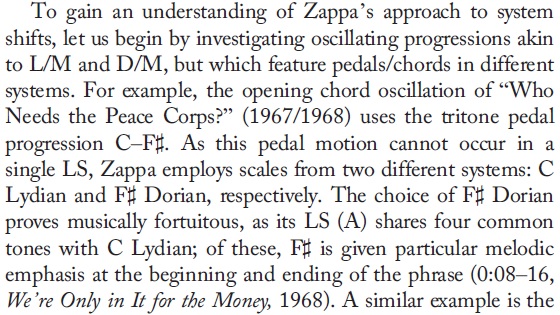
Brett Clement, A New Lydian Theory for Frank Zappa's Modal Music (Music Theory Spectrum, Spring 2014, page 161).
Since I'm not hearing a D/D# upon the F# pedal parts, the scale upon F# might be called minor too. LS A stands
for Lydian system A (see the left menu for its meaning). Anyway, in case of F# minor there are five tones in common
and it would be Lydian system D in Brett's terms. In his Response to me, Brett writes "not enough melodic info,
I'd guess Dorian instead". So Brett isn't positive about this episode being in minor or Dorian either.
- 0:21 Theme 2 in A Mixolydian.
- 0:26 Theme 1.
- 0:38 Theme 2, extended instrumentally.
- 0:57 Theme 3 in F Lydian.
- 1:14 Variation upon theme 1.
- 1:24 Theme 3.
- 1:42 The chord alternation from theme 1 is maintained to the end.
- 2:43 End.
See the Burnt weeny sandwich section for an overview of the use of scales in all examples in this study.
3. Concentration moon (1968)
The set-up of "Concentration moon" is as follows:
0:00 Theme 1, phrase 1. This section is in Bb, the meter being 3/4. The chord progression, being used here, is an easy going one: I-IV-I-V 7th-V and back to I. The first
example below is the opening of the song, showing this progression in bars 1-4 and bars 5-8.
Concentration moon, theme 1, phrase 1 (midi file).
Concentration moon, theme 1, phrase 1 (transcription).
0:24 Theme 1, phrase 2. The progression here is VI-II-IV-V, still in Bb, followed by four more bars with only an F pedal.
0:41 Theme 2, phrase 1. The bass pedal note switches to C. The set of notes remains the same, thus the scale becomes C Dorian. Here you've
got a single vocal line, instead of the close harmony group from the first example. The melody goes downwards, while the pass plays a simple figure upwards,
thus creating a light form of counterpoint (bars 1-2 of the second example). The harmonies are now less common: I-III-IV 11th (no 5th)-VI 9th (no 3rd).
0:52 Theme 2, phrase 2. This part doesn't follow a single scale, nor a single pedal note. As shown in the second example:
- bar 3: Bb pedal plus a Dm chord.
- bar 4: Bb pedal plus Am-5.
- bar 5: Db pedal plus Fm7.
- bar 6: chromatic movement.
See "Concentration moon (1971)" from the Playground psychotics section for how the band varied
these bars live in 1971.
Concentration moon, theme 2 (midi file).
Concentration moon, theme 2 (transcription).
1:05 "Tomorrow ...". Whispering voice (see above at track 1).
1:13 "Hi boys and girls ...". The famous Jimmy Carl Black line one more time.
1:17 Themes 1 and 2 repeat.
2:22 End.
4. Mom & dad (1968)
The structure of this song can be readily followed, using the arrangement in the FZ Songbook vol. I, pages 84-87:
- 0:00 Two instrumental bars in E Dorian are used as a transitional element all through this song. This
is their first appearance as a little instrumental intro.
- 0:04 Theme 1 ("Mamma ...") with a chord progression, not belonging to one specific scale.
Nominally the example below is in E Dorian or minor. It begins like that and the text of theme one ends here with "lay" (not shown below),
coinciding with the first chord of the instrumental bars, that follow upon it. It thus begins and ends in E Dorian,
but in between it's more multi-scale oriented. With the C being natural during bars 3-8 one might also decide for E minor
as the best fitting scale and interpret the C# and F natural as altered notes.
- 0:21 The instrumental bars.
- 0:24 Theme 2 ("You'll sit ...") in C.
See "Mom & dad (1971)" from the Playground psychotics section for a live version
of the intro and themes 1-2.
- 0:34 The instrumental bars.
- 0:39 All of the above from theme 1 onwards gets repeated.
- 1:10 Theme 3, phrase 1 ("Ever take a minute ..."), in F Lydian.
- 1:21 Theme 3, phrase 2 ("Ever tell your kids ..."), with a Bbmaj9 - Abmaj9
chord alternation. What you hear are major sonorities, not attributable to
one or two particular scales (I earlier referred to these bars as Bb Mixolydian, but
that was too hastily). Combined you've got A natural next to Ab and
individually these chords with their melodies don't generate enough notes to be sure about a scale.
- 1:30 Theme 3, phrase 3 ("Ever wonder why ..."), in D Dorian.
Mom and dad, 1:40-1:58, piano arrangement from the Songbook (midi file).
Mom and dad, 1:40-1:58, piano arrangement from the Songbook (score).
- 1:40 The instrumental bars and theme 1 return.
- 1:57 The instrumental bars, followed by a variation upon theme 2 as the coda of this song.
With the final sentence ("they killed her too"), the song neatly modulates back to the E Dorian
tonality from the beginning. The latter you could call "by the book" as it comes to classical
tonality.
- 2:16 End.
The meter of this song is 4/4 without rhythmic difficulties, on three occasions interrupted by a bar in 2/4.
5. Telephone conversation
"Telephone conversation" is a recorded telephone call between two of Zappa's friends, with one woman warning the other about her father looking for her. This is the real life conversation as it went (though not in full), including the phone ringing and an operator, thus without manipulating the tape or electronic/instrumental additions. The lyrics of the next track must be meant as Zappa's reaction to this situation.
6. Bow tie daddy
This next song, "Bow tie daddy", is musically in an
interbellum style for a change. It has its basis in C (most specifically bars 1, 4 and 5), but keeps changing scales frequently. From
bar 8 onwards the modulations start to dominate. The lead melody is rhythmically
characterized by its alteration of on beat notes and various forms of syncopes. The syncopes are created via triplets, bows and
dotted notes.
See also the Lumpy gravy section for "It's from Kansas" for another example of such music.
Bow tie daddy, opening (midi file).
Bow tie daddy, opening (transcription).
Compared to other rock composers Zappa's inclination to use non-traditional harmonic patterns is one of his
distinctive features. We'll see a lot of it in the coming sections. It is understandable that Zappa liked to
put the accent on this in his interviews, but if he didn't apply normal patterns as well his albums would never
sell and Zappa would never have reached the status and financial independency as he has done. Apart from "We're
only in it for the money", we have albums as "Apostrophe (')", "Sheik Yerbouti" and "You are what you is", that
show Zappa's commercial side and sold well for Zappa standards.
As he himself has remarked the London Symphony Orchestra
recordings would have been financially impossible without these albums.
One of the things that bothered Zappa for a while was to get his music played on the radio and the production of a hit single. Why some singles become hits and others don't is a territory that has many haphazard elements in it. It certainly helps to write a catching melody, that has the effect on people of "gee, I'd like to hear this again", also when only half listening. But fashionable aspects in the sound building and a direct emotional appeal get in the picture as well.
Zappa had no specific sense for writing hits and besides that he refused to adapt his lyrics to a level that wouldn't offend anybody. Eventually Zappa
did get two hits when has name was already well known. "Bobby Brown" from "Sheik Yerbouti", an example of a song with a catching melody, hit
the charts in two European countries, where the lyrics formed no real problem, and "Valley Girl" from "Ship arriving too late for a drowning witch" sold
well in the U.S. The latter due to a gimmick in it, with his daughter Moon portraying a spoiled west coast teenage girl. See the Does humor belong in music and
Drowning witch sections for more about these two songs.
7. Harry you're a beast
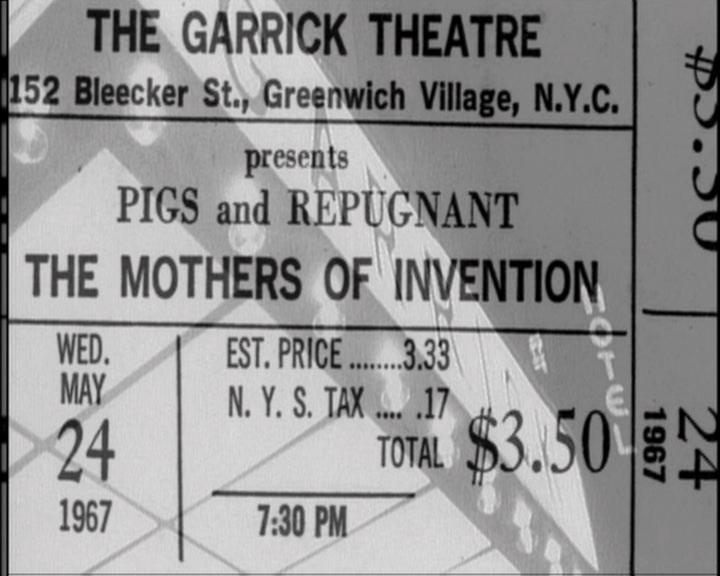 The score of this song used to be available via www.zappa.com in an arrangement by Jon Nelson. You could try to contact the ZFT for a copy.
The song has lyrics on "We're only in it for the money", but can be heard in an instrumental version on "Make a jazz noise here" and
"Lumpy Money". It's a short song with the following harmonic basis (with the times from the "We're only in it for the money" version):
The score of this song used to be available via www.zappa.com in an arrangement by Jon Nelson. You could try to contact the ZFT for a copy.
The song has lyrics on "We're only in it for the money", but can be heard in an instrumental version on "Make a jazz noise here" and
"Lumpy Money". It's a short song with the following harmonic basis (with the times from the "We're only in it for the money" version):
- 0:00 Piano intro with the chord progression F#m-Bm-D-E as arpeggios, continuing with playing through E7-9.
- 0:11 Theme 1 in A Mixolydian.
Harry you're a beast, 0:12-0:33 (midi file).
Harry you're a beast, 0:12-0:33 (transcription).
Theme 1 is a friendly easy going melody, with standard chords and without any rhythmical difficulties. If it weren't for the lyrics, it could be used for
a middle of the road love song. The chords are played lightly in the background, being A-Gmaj7-Em-A-Gmaj7-Bm-A-Gmaj7-C-Bm-A-G-A-G-A. Only the voicing
of the Bm chord at bar 4 is a little odd, with the vocalist making a larger jump of a sixth, and you've got one altered note, a C natural during bar 6.
- 0:30 Theme 2, phrase 1. Chromatic parallel movement of major triads, F-F#-G.
- 0:38 Theme 2, phrase 2. Two more major triads, G-A.
- 0:44 Snorks with some atonal accompaniment.
- 0:51 Theme 2, phrase 1, some more.
- 0:59 Theme 3 with C#7-B7.
- 1:06 Theme 4. Instruments: first an Ab+Eb - Db+F alternation (as single notes), followed by a second B+F# - E+G# alternation. Vocals: an Ab-Bb alternation, followed by a B-C#
alternation. The second formation is a transposition of the first one.
- 1:13 The progression F#m-Bm-D-E from the opening is now used as a coda.
- 1:21 End.
With the exception of theme one, this piece is very much composed as a progression of chords, unrelated to an overall scale. Instead, these chords seem to imply
a scale each by themselves. It's diatonic with scale fragments. Only theme one
is stable in A Mixolydian, with a melody with a standard accompaniment. This matter is also discussed in my "The idiot bastard son" analysis in the
YCDTOSA Vol. II section of this study.
I seem to have miswritten myself in the table from my discussion with Brett Clement, where I put the tonic A in the Aeolian column instead
of the Mixolydian column (and the C# Locrian mark doesn't belong there). The song is obviously in A Mixolydian,
as also Brett indicates.
8. What's the ugliest part of your body?
"What's the ugliest part of your body?" is a returning song on "We're only in it for the money" in the shape of a collage.
Here things are getting more complicated. The chords are standard, but rhythmically it's complex: changing meters,
including odd ones, a tempo change and various syncopic forms in the lead melody.
It's made up of three themes as presented in the following block of transcribed bars:
- Theme A, bars 1-12: the main theme in doo-wop style. The bass is giving the root notes of the basic chord progression, being
I, VI 7th, IV and V in G. This four bar bass progression gets repeated three times. The doo-wop element lies in the accompanying
vocal harmonies in the second staff.
- Theme B, bars 13-20: the second theme in 7/8 falls in abruptly. In fact it has nothing in common with theme A. The meter
is different, the tempo is different and the keys are different, so you could
just as well say that a new song is starting here. It's using more than one scale, the chord progression in rock notation
being C, A, Am7 and D.
- Theme C, bars 21-24: a third theme in the same tempo as the previous one. This one is doing a little sequence gliding through
scales as well. The progression here is formed by three minor chords going down, following the chromatic scale, followed by one major chord:
Bm, Bbm, Am (plus a vague D in the bass) and Ab. In staff 2 a second voice is singing a quarter note behind the
lead vocal, somewhat softer in the background, thus creating an echo effect.
What's the ugliest part of your body?, section (midi file).
What's the ugliest part of your body?, section (transcription).
The collage construction of this song is set up via two means:
- The song itself can be split into two halves as indicated.
- The A theme is just sung once and doesn't return in the song itself. It returns much later on on the CD, namely 9 tracks
further ahead in the form of a reprise. During this second track the theme does get varied upon, though in an unconventional
way by speeding up its phrases.
9 Absolutely Free
Next is a section of the melody from "Absolutely free", being theme one from the overview below. The chords here are first
in F Mixolydian, I-II-I-V (bars 1-8), then in A flat, I-IV-V-VII (bars 9-12), followed by two closing chords in F Mixolydian, I-VII (bars 13-15).
Hereafter the song rolls back into I of the opening theme.
Absolutely free, opening (midi file).
Absolutely free, opening (score/transcription).
There's also an instrumental version of "Absolutely Free" to be found on "Lumpy money", disc III (chords, bass and drum).
The complete score of this song is available in the Frank Zappa songbook vol. I, pages 90-95. They are transposed, when comparing them
with each other. The above begins in F Mixolydian, the Songbook in G Mixolydian and the instrumental track in D Mixolydian.
The global structure of this song, following the Songbook, goes as:
- 0:00 Modern instrumental opening with enlarged chords and untraditional harmonic formations, like stacking fourths and fifths.
It's played exactly as the piano part from the Songbook. The along coming guitar tabs seem to suggest different possible harmonizations.
The first piano chord is F#-B-C#-E-A# (F#7 add 4), while the first guitar tab says F#-A#-D#-G# (stacked fourths, indicated as F#9 add 6).
- 0:33 Spoken intro ("The first word ...").
- 0:39 Theme one as presented above ("Discorporate ..."), played twice. Quite unexpectedly in this context you can hear it end
with "flower power sucks".
- 1:18 Theme two ("Diamonds on velvets ..."), a character variation upon theme one. The first two chords of theme one, G and Am (Songbook pitches),
are now used as a chord alternation.
- 1:38 Theme three ("Unbind your mind ...").
- 1:58 Theme four ("Freedom, freedom ...").
- 2:15 Themes 2-4 repeat with partially different lyrics.
- 3:05 Coda.
- 3:24 End.
Absolutely free, end, Songbook arrangement (midi file).
Absolutely free, end, Songbook arrangement (score).
The "da-dat-da" bars are chromatic. The very end with "You'll be absolutely free, only if you want to be" is basically the same on record as in the Songbook:
a melody sung over a descending progression (G-F-Em-Dm (album pitches) or A-G-F#m-Em (Songbook pitches). Still the positioning of these
chords is such that the Songbook version sounds different. In the Songbook the piano plays around these chords. On the album
the descending bass dominates. So the song ends in D Dorian or E Dorian respectively.
10 Flower punk
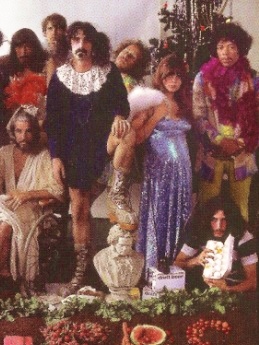 "Flower punk" contains a repeating theme, its structure being relatively easy compared to the songs from above. The overdubs at the end
however give this song a quite unusual character: on one channel you
hear a hippie dreaming about achieving his ideals while on the other channel a manager talks about how to invest all the money
that comes from it.
"Flower punk" contains a repeating theme, its structure being relatively easy compared to the songs from above. The overdubs at the end
however give this song a quite unusual character: on one channel you
hear a hippie dreaming about achieving his ideals while on the other channel a manager talks about how to invest all the money
that comes from it.
Flower punk, 0:00-0:13 (midi file).
Flower punk, 0:00-0:13 (transcription).
This theme is made up of two quite different phrases:
- Bars 1-2 in 4/4 with the progression B-(B7)-B-E-B-A-B in B Mixolydian. The track is sped up to getting between keyboard pitches (Rykodisc RCD 10503).
B quarter-tone sharp Mixolydian is actually the more accurate key as it comes to what you hear. See also below at "Lonely little girl". I can't tell
what the pitch was before speeding up.
- Bar 3 in 12/8 with the progression G-D-A-E. The music is shortly passing through G and A (major or Lydian), with the singers and the accompaniment
following contrary melodic movements.
These two phrases are getting repeated till half-way the song. Then it fades out and the bass motifs from it get varied upon with the mentioned overdubs.
Phrase two is a variation upon the main theme from "Hey Joe" by W. Roberts, best known in the version of the first hitsingle by Jimi Hendrix.
Hendrix is present on the inner sleeve construction set for the album. To the right a section from one of the photos taken during the session,
with Hendrix, the Mothers, Gail and Frank with his foot on a Beethoven bust ("Lumpy Money" booklet). It got
turned into a collage by Cal Schenkel, filling up the empty space with among others pictures of famous people. Hendrix gave Zappa one of his burnt Strats,
which he let repair. See the Dominic Chevalier book, page 97, for a large photo of it. Hendrix put
his guitar in the center of his music, using many guitar effects like feedback. He turned out to be a good soloist too as you can hear on "Band of gypsies",
his only official live album. Because Zappa normally kept good relationships with fellow rock stars, the hostility towards the hippie movement in
the lyrics of "We're turning again" from 1985 caused some estrangement among some people.
11 Hot poop
With this track and the next one Zappa continues with the idea of adding collages to this album. MGM objected to some sentences Zappa had recorded
and forced him to disguise or eliminate them. Because of this there are small version differences between some releases, as discussed
in the Cosmic Debris book by Greg Russo, son of revisited version, page 62. This applies for instance to "Hot poop". This smaller track
is a collage of three unrelated sections:
- 0:00 Some more of the whispering by Gary Kellgren as commented upon in the interview screenshot at track 1.
- 0:14 Theme three from track 18 below with different lyrics. It appears to be a line including the word fuck or fucking to which MGM objected.
So it got eliminated on track 18 and here the line is played backwards.
Hot poop, section (midi file).
Hot poop, section (transcription).
This is the example from below with theme 3 from "Mother people" (album version), notated backwards and played backwards. It indeed becomes to sound as "Hot poop",
though the lyrics of the eliminated line are different.
- 0:20 Snorks.
- 0:26 End.
12 Nasal retentive calliope music
Zappa describes
"Nasal retentive calliope music" as the overture to side two of the original vinyl album. This side contains a series of songs he had in stock, not
specifically addressing themselves to the hippie movement.
Nasal retentive calliope music, 0:22-0:27 (sketch).
From the point view of studying all of Zappa's music independently of its nature, the existence of sound collages in his output is problematic.
It is musical, so something that should be looked at, but it's hard to catch
in standard notation and even impossible to convert into midi format. The above is only a small fragment from "Nasal retentive calliope music"
with the status of a sketch only. You've got layers of electronic noises and hisses on top of each other, that have pitches to a degree.
It visualizes on a very small scale some elements that you can also readily hear: it is atonal, it knows no meters and it's irregular. But it doesn't
specify the non-standard electronic sounds.
Percussion is present with
mutated sounds too, where I've limited myself to distinguishing lower and higher beats only. Better recognizable are the two vocalists. One
is saying "beautiful". The other is the often quoted line by Eric Clapton, where he's reacting to a fan of his having painted "Clapton is God" on
a wall. The piece ends with the opening from "Heavies" by Paul Buff, a single by the Rotations, that Zappa and Buff worked on in 1963.
It's blues based surf music, brutally cut off for the next song.
13. Let's make the water turn black (1968)
Next are the outlines of "Let's make the water turn black", based upon the Songbook:
- 0:00 Instrumental opening in C with the Csus2 chord as an arpeggio.
- 0:07 Central theme ("Now believe me ..."). For the intro and this main theme you can follow the transcription of the
instrumental live version of "Let's make the water turn black (1988)",
as included in the Best band you never heard in your life section of this study. It doesn't go identical, but reasonably comparable.
- 0:21 Central theme repeats ("Early in the morning ..."), its last two bars going differently.
- 0:35 Theme 2 in G Mixolydian ("Whizzing and ..."), being a character variation upon the central theme.
It's taking over the rhythm of the central theme with the eighth note as central time unit, but has a melodic line and chords of its own.
The meter is 4/4 all through this song.
Let's make the water turn black, 0:32-0:49, piano arrangement from the Songbook (midi file).
Let's make the water turn black, 0:32-0:49, piano arrangement from the Songbook (score).
This example from the Songbook begins with the last two bars of the repetition of the central theme. This theme starts brightly in C,
but soon altered notes are getting involved. These two ending bars follow a parallel progression of major triads: Bb, A and D.
It's something Zappa does more often, with the effect that such a movement doesn't belong to one specific scale. Theme 2 begins
in G Mixolydian but starts to evade from this key pretty soon as well. As you can see the last four bars from the example from above
contain a progression of six major triads, only interrupted once by a Fm chord. So it's much multi-scale oriented, though in this
case the final chord confirms the tonic of theme 2.
- 0:49 Central theme ("Ronnie saves his numies ..."), its last two bars again going differently.
- 1:04 Theme 3 in E Dorian, another character variation upon the central theme.
- 1:17 Theme 2 returns.
- 1:31 Central theme ("Ronnie is in the army ...").
- 1:44 The last two bars of the central theme are
played as during the second repetition and get repeated twice. It's getting lightly varied upon
at the end by letting the final chord switch from Am to A. Not letting a song end upon the tonic is normal in Zappa's music.
Here the end has something of a deceptive cadence as well. While the Am chord belongs to the C major scale of the central theme, the
A chord suggests a switch to a different key:
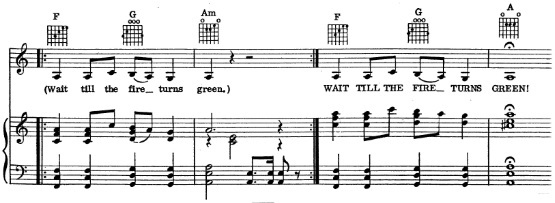
- 1:52 Little collage of spoken parts.
- 2:00 End.
14. The idiot bastard son (1968)
Three versions of "The idiot bastard son (1968-84)" get dealt with in the YCDTOSA II section of this study:
the first 1968 recording, a 1974 live version and the re-mix from 1984 with newly recorded bass and drums part. The current CD features
the original 1968 recording, while the 1984 re-mix is available on the ZFT release "Lumpy money". See also the Ruben and the Jets section
for these re-mixes.
The idiot bastard son, 1:55-2:16, album version (midi file).
The idiot bastard son, 1:55-2:16, Songbook version (midi file).
The idiot bastard son, 1:55-2:16, album version (transcription).
The idiot bastard son, 1:55-2:16, Songbook version (notes).
The example from above contains bars 58-70 from the Songbook in a version following the 1968 recording and the piano arrangement from the Songbook itself.
Bars 58-66 are a variation upon what I'm calling phrase 2 of theme 1 in the YCDTOSA II section. Bars 67-70 contain the opening of the add-in, that, to a degree,
one might also call a variation upon the previous: bars 67-8 begin as bars 58-9. The difference between the recording and the album lie in a transposition,
F# minor versus E minor, and the harmonization. More than on the album the Songbook is making use of extended chords. Both are applying an 11th chord in bar 61, Em11 (Songbook) and F#m11 (album).
The album contains an incomplete D9 chord in bars 64-66, while the Songbook is using a progression over a broken Csus2 chord. Not indicated in the Songbook are the following additions on the album:
- 0:46-1:13 and 2:49-3:18: collages of spoken parts.
- cracking sounds at "boy", "green" and "pew".
Instead the Songbook asks the player to stomp on the floor in the final bar.
15. Lonely little girl
Zappa frequently sped up tapes for his CDs. Sometimes this conclusion can be derived directly: by speeding up a track arbitrarily, you can get at
frequencies that are out of tune with keyboard frequencies. This is for instance happening on the current CD issue of "You are what you is".
Sometimes the speed is thus going up, that it's getting to sound unnatural if humans were to play it like that. Quite obviously
this is happening in "A vicious circle" from the next section of this study. In case of "Lonely little girl" Zappa sped up the tape,
causing a transposition of exactly a minor third. In such instances you can only indirectly draw a conclusion that the pace has been
changed, namely if you get the chance to listen to the original track. This is the case for "Lonely little girl". The theme structure, chords
and timing go as:
"We're only in it for the money" version:
- 0:00 Intro with an Ab-Ebm alternation in Ab Mixolydian, ending with C#-B.
- 0:10 Theme 1 with Ab-Ebm as bass alternation.
The Ab chord is played over both bass notes, at some points extended with an F or Gb, so the total harmony can get extended towards Ebm11.
- 0:22 Theme 2 with Bbm-Eb-Cm-F, played twice.
Lonely little girl, 0:08-0:26 (midi file).
Lonely little girl, 0:08-0:26 (transcription).
- 0:32 Theme 3 with Gm-Ab.
- 0:40 Theme 4 with Cm-Bb-Fm-Eb.
- 0:44 Theme 5 with Gm7-C, ending with improvising over Gm.
- 1:08 End.
"Lumpy money", instrumental version on disc III:
- 0:00 Intro with an F-Cm alternation in F Mixolydian, ending with Bb-Ab.
- 0:11 Theme 1 with F-Cm as bass alternation.
- 0:22 Theme 2 with Gm-C-Am-D, played twice.
- 0:37 Theme 3 with Em-F.
- 0:47 Theme 4 with Am-G-Dm-C.
- 0:52 Theme 5 with Em7-A, ending with improvising over Em plus A, in the position B-E-G-A.
- 1:26 End.
The duration relationship can also be calculated. Speeding up a track to double-speed multiplies frequencies by 2 or an octave.
With 12 minor seconds in an octave you get the 12th root of 2 = 1,05946 as multiplying factor per minor second. The transposition
above is with a minor third or three times this multiplying factor. For the starting point of theme 5: 0,44*(1,05946)³ = 0:52.
The end got lightly edited, so this doesn't go for the whole song.
16. Take your clothes off while you dance
Zappa first recorded "Take your clothes off while you dance"
as an instrumental in 1961. An example is included in the Paul Buff section.
This version is its first public release, this
time with lyrics. Another instrumental version would appear as the closing track on the next album, "Lumpy gravy".
Take your clothes off while you dance (words-chords).
Above are two small-format samples of the lyrics-chords from this song as published by Kobalt music, following the "We're only in it for the
money version". It's pretty different from the original jazz type of playing it.
17. What's the ugliest part of your body? (reprise)
Track 17 is the reprise of "What's the ugliest part of your body?", as already mentioned above at track 8.
Only the first theme of track 8 returns, of which a transcription is included above.
The example below is a section of how it gets played during track 17.
What's the ugliest part of your body? (reprise), 0:18-0:35 (midi file).
What's the ugliest part of your body? (reprise), 0:18-0:35 (transcription).
It gets played normally till 0:28, with some additional voice-overs. Next, from bar 6 onwards in the example, the melodic and harmony notes become chromatic with
the chords being a bit out of tune. At first the tempo is maintained as it is. From bar 9 onwards it continues as a collage, without a specific meter,
with mingling sped up tapes and other voice-overs. At 0:56 it ends with a couple of seconds with some more snorks, a voice saying "do it again" and
some rapid electronic ticks.
18 Mother people
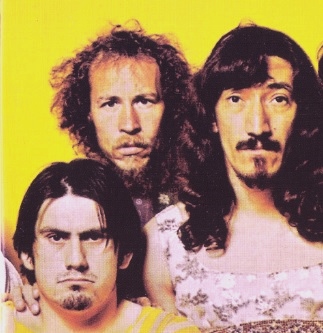 Next is a fragment of the melody of "Mother people" with the chords progression I-IV-V-VI-IV-V-I in D written
beneath it (what you hear on the album is yet another sped up track, a minor third higher). Notable is that for the bass Zappa
lets the tonic D rapidly go down to C natural, a chromatic note. Something similar happens in bar one from "Who needs the peace corps"
from above, where the tonic C is swiftly left for a Bb. Rhythmically the three
presented bars offer three different forms in 3/4. The first bar is on beat. The second is syncopic between beats one and two. The third bar
is 3/4 subdivided into 4. To the right Don Preston, Roy Estrada and Jimmy Carl Black as on the CD cover, wearing dresses.
Next is a fragment of the melody of "Mother people" with the chords progression I-IV-V-VI-IV-V-I in D written
beneath it (what you hear on the album is yet another sped up track, a minor third higher). Notable is that for the bass Zappa
lets the tonic D rapidly go down to C natural, a chromatic note. Something similar happens in bar one from "Who needs the peace corps"
from above, where the tonic C is swiftly left for a Bb. Rhythmically the three
presented bars offer three different forms in 3/4. The first bar is on beat. The second is syncopic between beats one and two. The third bar
is 3/4 subdivided into 4. To the right Don Preston, Roy Estrada and Jimmy Carl Black as on the CD cover, wearing dresses.
Mother people, opening bars (midi file).
Mother people, opening bars (notes).
Most of the score of this song is available in the Frank Zappa songbook vol. I, pages 30-33:
- 0:00 Theme one as the instrumental opening from above.
- 0:09 Theme one with lyrics ("We are the other people ...").
- 0:19 Theme two, phrase one ("Do you think that ..."). Though notated as a bit faster, it sounds as going slower because the main time unit
goes from an eighth note to a quarter note.
- 0:28 Theme two, phrase two, ending with three instrumental bars.
- 0:39 Theme three as shown below. The meter turns to 7/8, followed by 4/4. The two 7/8 bars aren't played literally like this on the album. Apart from the
transposition with a minor third (as mentioned above), the chords from staff two got skipped. It makes the overall sound quite different.
This theme begins in A Dorian (transposed to C Dorian on the album), and ends like being in E Dorian. When you would include the Csus2 chord from the
Songbook you're getting at an enlarged chord: Am by the bass plus Csus2 is Am11 in total.
The two 4/4 bars are harmonized in the same manner.
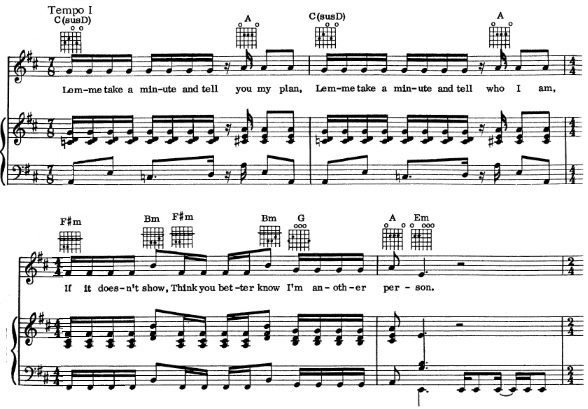
Mother people, theme three, Songbook arrangement (midi file).
Mother people, theme three, album version (midi file).
Mother people, theme three (notes/transcription).
- 0:46 Theme two, phrase two.
- 0:57 Theme three. The Songbook has different lyrics for this repetition of theme 3: "Better look around before you say you don't care ...".
- 1:04 Theme one.
- 1:23 Theme two, both phrases.
- 1:39 Scratches.
- 1:42 Citation of "I don't know if I can go through this again". See
the 2nd example from that particular track from the next section.
- 2:19 Theme three.
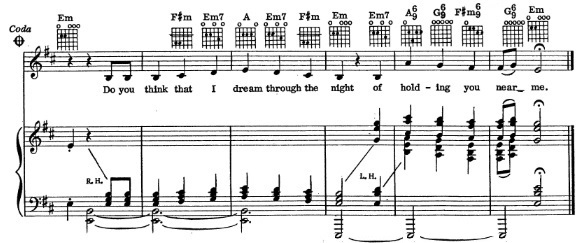
Mother people, coda, Songbook arrangement (midi file).
- 2:25 End. While the album ends with theme three, the Songbook is using theme two, phrase two, as the coda (in a 3/4 meter). It's harmonized more intensively
when compared to how this phrase two is played on the album. The Songbook is official material and the piano arrangements by Ian Underwood
are often the way he played it himself when he was in the band. In both cases, finishing with theme 2 or 3, the song
would end in E Dorian.
19 The chrome plated megaphone of destiny
With "The chrome plated megaphone of destiny" the idea of creating collages has resulted in a full-blown piece of 6:25 minutes.
The CD leaflet contains an instruction by Zappa, that, because it's printed over a photo, is almost illegible. Only the head
with a reference to Kafka's book The penal colony is clear. The track can be subdivided into a couple of sections with sound effects
and modern atonal music. No additional players are credited on the album, so it must be the Mothers themselves playing all this:
- 0:00 Hiss.
- 0:02 Upcoming drone.
- 0:27 Three pianos.
- 1:11 High piccolo notes with flute, clarinet, mutated sounds and percussion.
- 2:48 Lower chords with sustained notes.
- 3:16 Mutated sounds and voices laughing.
- 4:37 Snare instruments with melodies and arpeggio-like strings.
- 5:34 Drone fading out.
- 6:25 End.
The chrome plated megaphone of destiny, 0:46-0:52 (midi file).
The chrome plated megaphone of destiny, 0:46-0:52 (transcription).
The above is a fragment from the piano section. It's made up of three, maybe four piano parts, divided over the left-, right- and middle-channel
of the stereo field. It's played fast, so only six seconds already take up a page with notes. My guess is that it's a directed improvisation.
That is Zappa gave the outlines of what he wanted to hear and
it got filled in on the spot during the recordings. Probably they are also edited tracks from various takes. The 3/4 meter in this example
is only my notational choice. I used the high descant notes from staff two to give it a legible structure, but needed some tempo changes this way.
It's atonal music with notes getting repeated in varying rhythms, next to smaller motifs.
No matter what you do
Included in the "'Tis the season to be Jelly" bootleg is a love song parody called "No matter what you do", that the Mothers played in 1967. This
bootleg got an official status for its inclusion in the "Beat the boots" series. "No matter what you do" is a collage of textual
and musical conventions. The exact origins of this song are a mystery. Everything
on it sounds thus familiar that the chances that Zappa is arranging material here from his fifties single collection
are a lot bigger than that he wrote the (entire) song himself. Halfway the booklet of "MOFO" there's a sheet
with a "must record" songlist in Zappa's handwriting, where this song gets mentioned by its opening lyrics
as "I could be a slave". There are various other titles on this list, that aren't on Zappa's official albums.
Two that have become known via ZFT releases are "Groupie bang bang" and "Bust his head".
The purposes of this sheet remain uncommented upon. "No matter what you do" is made up of three blocks:
- Opening lick ("No matter what you do") in Bb Mixolydian (more or less, the bootleggers tampered with the speed) with
as progression I-II-VII. The riff
surprises by its joyful impact. Zappa also used it for "All night long", a song on the "Animalism"
album by The Animals, that he got credited for as arranger. Apparently he didn't consider himself the writer of that specific song.
The origins of "All night long" are a mystery just as well, thus not bringing a solution any nearer. There are at least three popsongs
with the same title. One by Johnny Otis, one by Joe Houston and one by Lionel Ritchie. None of these correspond to "All night
long" on the "Animalism" album. Biographer Kevin Courrier states that "All night long" was written by Harris Woody,
turned into a big hit by Chuck Higgins back in the fifties. It looks as if he's mixing things up. Harris Woody gets wrongly
credited for "All night long" on the "For real" album by Ruben and the Jets (that's the one Joe Houston played). Zappa was indeed a fan of Chuck Higgins' biggest hit
"Pachuko hop/Motorhead baby", but I couldn't find anything about an "All night long" by him.
No matter what you do (Trad./(Arr.) Zappa), opening bars (midi file).
No matter what you do (Trad./(Arr.) Zappa), opening bars (transcription).
- Second theme ("I don't care how you treat me"). Though the music of "No matter what you do" is comparted into three
blocks, this is not the case with the lyrics. Regarding the text "No matter what you do" is consistent. The lyrics of
the opening lick however would fit less into "All night long", where the lick is played as an instrumental intermezzo. On "No matter what you do"
the opening lyrics go as: "I could be a slave for the rest of my life, if only you could be my wife ... no matter what you do,
can't hide my love for you". This is not specifically related to the text of "All night long", whereas in "No matter what you do"
the follow up with "I don't care how you treat me" is quite logical. Then the question who is behind the music goes for the lyrics just the same.
- Third spoken block, that is using the slow theme from the 1st movement of Tschajkovky's 6th symphony in the background. The
lyrics, with the "big tits" punch line, are undoubtedly Zappa. "I married Joan" is a reference to a fifties TV series, but the music
from the title track from that series isn't used here.
